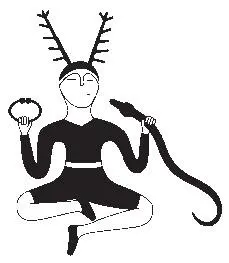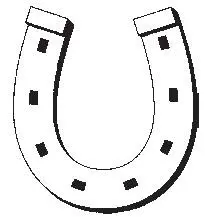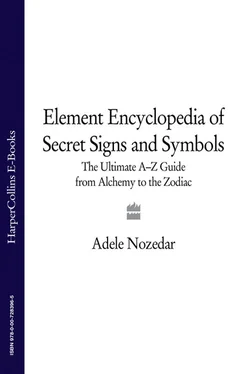These hex symbols are beautifully decorative and use universally familiar symbols in their design, including hearts for love, stars for good luck, oak leaves and acorns for strength and growth. They also use the image of a bird called a distelfink, a type of finch that lines its nest with thistledown. This bird is particularly associated with good fortune. The “double distelfink” brings double the luck.
See Seal of Solomon and I Ching.
To say that something is like searching for the Holy Grail implies that the search is for a highly treasured and elusive object that might never be found. If there is a genuine Holy Grail, like the Philosopher’s Stone, it has retained its hard-to-get status.
The Holy Grail legend has direct links with two mystical pre-Christian items; the magical cauldron of the Celtic Gods that never emptied and kept everyone satisfied, and the magical chalice that represents spiritual authority and kingship. However, received information about an actual physical Holy Grail says that it is either the cup that Christ drank from at the Last Supper or the vessel that caught his blood during his crucifixion. The sacred vessel subsequently went missing.
There is a rumor that a fragment of the true Holy Grail, known as the Nanteos Cup, is secreted somewhere in the United Kingdom, specifically in Wales. The cup, made of olivewood, is reputed to have been brought to Glastonbury by Joseph of Arimethea, where it was looked after by the monks who lived at the abbey. The Dissolution of the Monasteries in the sixteenth century, in which monasteries were abolished and their valuable property seized by the Crown, meant that the sacred relic had to be removed. It allegedly ended up at Nanteos Mansion near Aberyst-wyth. Although it is now just a small fragment of wood, water drunk from it is claimed to have healing powers. Sadly, this marvelous story currently has no forensic evidence to support it and so the Holy Grail remains true to its symbolic meaning, tantalizingly beyond our grasp, for the time being at least.
The Grail Legends of the Arthurian Tales also symbolize the quest for something beyond reach. The knights, galvanized into action to find this object of desire, soon realize that they are seeking something much more than a cup; given that the shape of the grail is a feminine symbol and a powerful emblem of the spirit, according to Jung it symbolizes “the inner wholeness for which men have always been searching.” As such, the Holy Grail has marked parallels with the Philosopher’s Stone of the alchemists, and an equally elusive nature.
See First signs: Horizontal line.

This symbol has a deep resonance for many, and was first discovered in the cave paintings of Ariège in France. These paintings date back to 10,000 BC. The figure may be the precursor to Cernunnos and other antlered deities. The horned shaman is also called the Dancing Sorcerer, said to represent a shaman performing a ritual ceremony. However, this theory cannot be proven conclusively.
Norse legends tell of a magical mead that was brewed from the blood of a wise God, Kvasir; to drink this mead would be to benefit from the wisdom of the God. Odin managed to find this drink, and the triple horns represent the three draughts that he drank.
The horn itself is both a masculine and phallic symbol, but because it can be used as a container, it encompasses the female aspect, too. The triple horn appears in stone carvings, over the heads of warriors, implying rewards in Valhalla, the Hall of Slain Warriors that is the home of Odin.
Today, the symbol is used as a sign of identity by followers of the Asatru faith. Asatru is a relatively modern religion that acknowledges the much more ancient pre-Christian Norse beliefs.

The horseshoe has acquired symbolic significance not because of its function, but because of its shape and the metal used to make it. It is shaped like the arc, one of the first sacred symbols that represents the vault of the Heavens. When it is “upside down” it is also shaped like the last letter of the Greek alphabet, the Omega.
Flip the horseshoe the other way up, however, and it resembles the crescent Moon, therefore invoking the protection of the Moon Goddess. The iron that the horseshoe is made from further enhances this protective quality. Iron is a protective metal, which evil entities will go out of their way to avoid. The horseshoe also looks like the yoni, further strengthening its links with the Goddess.
The horseshoe is a well-known good-luck symbol and appears on greetings cards, wedding souvenirs, and the like. People nail them up over doorways for the same reason, although there is some controversy as to which way up the horseshoe should go. One school of thought says that it should rest on its curved end to hold in the luck, which, if the horseshoe were reversed, would pour away. However, pre-Christian superstition says that the horseshoe should be positioned so that it looks like the sky, and also like the yoni.
The function of the hourglass is to mark the passing of time, as sand trickles through the narrow waist in the middle of the transparent glass container that is the same shape as a figure of eight. Therefore, the hourglass is often used as a motif to show the inevitability of death.
However, the shape of the hourglass, as well as being a visual symbol and a word used to describe the figure of a shapely woman, is a lemniscate, or infinity sign. This indicates eternity. That the hourglass can be turned upside down to start the cycle all over again makes it an optimistic symbol of rebirth.
The I Ching is an ancient Chinese system of philosophical divination, possibly dating back to the eighth century BC, which is still in use today.
The I Ching, or Book of Changes, was the only book that escaped destruction when all the Chinese philosophical works were burned in the third century BC. Either dried yarrow stalks or special coins, usually with square holes in the center, plus knowledge and a fair sprinkling of intuition, are the tools of the I Ching.
The basis of the system is just two simple lines, one continuous, one broken. The most profound symbols are usually the simplest, and these two lines encompass the universal source of all things, also known as the Tao (as in Taoism).
The unbroken line represents all aspects of the positive; male, Sun, fire, heat, action, odd numbers, yang. The broken line represents the opposites.
These lines combine to make 64 possible combinations.
The lines also form a set of eight trigrams that represent the elements of air, water, fire, and earth, with the four sub-elements of breath, sea, thunderbolt, and mountain.
The interpretations of the I Ching are beautifully oblique; the philosophy behind this system is about finding balance. Both the flags of Vietman and of South Korea feature trigrams from the I Ching.
Early Icelandic grimoires (magical texts full of spells and occult information) contain long lists of curious, angular-looking symbols, all intended for a specific purpose. Their origins go back to the ancient rune system, with a sprinkling of later medieval and Renaissance magic thrown in for good measure.
Читать дальше














